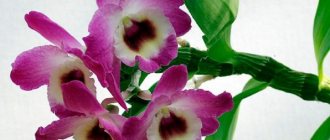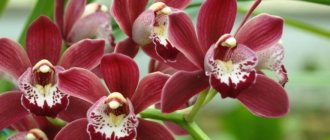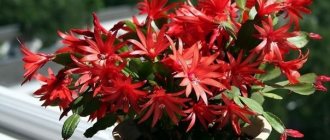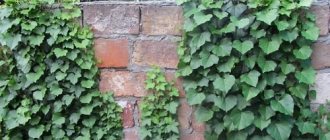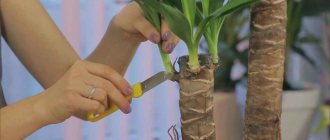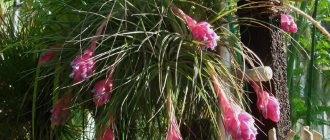Characteristics of the plant
Only two varieties of aphelandra are grown as a houseplant:
- Protruding (aka Aphelandra squarossa) with yellow inflorescences. The species has a longer flowering period - from late spring to mid-autumn.
- Orange (aka golden) with orange-red spikelets. This plant does not bloom for long, at the beginning of autumn. But it always sets fruits, which are used for seed propagation of the flower.
Even with the best care, the maximum period that aphelandra can live is two cycles (years). It grows quickly, which means it quickly loses its lush shape, the bush becomes bare. To preserve the plant, it is taken from cuttings in the spring. It can be done every year, or even in the third year of life.
Afelandra - home care and maintenance requirements
The flower retains the dark green shine of the leaf plates and the contrasting color of their veins only if it has enough light. The lighting should be good, but diffused; the best option is an eastern window. Do not allow direct rays to hit the bush - they will leave spots on the leaves.
All types of aphelandra are heat-loving, but cannot tolerate heat. The maximum temperature in the room should not exceed 25 °C. For the winter, it is advisable to send the bush to a cool place so that it can rest and prepare for the next flowering. At the same time, it is important not to allow the temperature to drop below plus 15 °C, otherwise the bush will die.
Aphelandra care consists of the following procedures:
- Watering frequently, but in small portions. The soil should not dry out, but it should not be flooded, so as not to rot the roots.
- Regular spraying - the flower needs high air humidity.
- Feeding during the growth period until the end of flowering with mineral complexes.
- Replant every spring in fresh soil, but the pot should not be too large.
- Forming a bush by pinching the tops of shoots. Then they will give off side branches, and you will get a lush curtain.
After the aphelandra flowers, reduce watering and take the pot into a cool room. And in the spring, the shoots are greatly shortened so that the bush rejuvenates. Or they take cuttings and root the tops.
Problems during cultivation
One of the most common problems is dropping leaves. The cause may be insufficient lighting, low temperature, poor watering and drafts. If the tips of the leaf blades turn brown, then most likely the humidity is too low. The leaves turn yellow, the inflorescences become smaller - the cause may be excessively acidic soil. However, the flower does not grow in alkaline soil. The optimal indicator is pH from 4.5 to 5.5.
Aphelandra will grow slowly if you do not feed it periodically. Although the flower is quite sensitive to deficiency or excess of minerals:
- N deficiency leads to yellowing of leaves, excess N inhibits flowering;
- lack of P – inflorescences become smaller, color intensity decreases;
- K deficiency manifests itself as yellow and brown spots on leaf blades.
Aphelyandra is sometimes affected by aphids, mealybugs, and scale insects, when brown tubercles appear along the veins. In this case, you need to wipe the leaves and stem with a sponge with soapy water and spray with an insecticidal agent (Aktellik or Fitoverm). In case of fungal infections, manifested by rot, weeping spots, wilting, all affected parts are removed, and the plant is treated with fungicides (Skor, Topaz, etc.).
Description of the plant
Aphelandra (translated from Greek as “simple man”) belongs to the genus of flowering perennial shrubs, the Acanthus family, 196 species of this plant have been described. It can be found in Central and South America in the jungles of the tropical and subtropical zones, where the height of the plant reaches two meters.
At home, it has a height of up to 0.5 meters, a lignified trunk, leaves in the shape of an ellipse, glossy, the tip is pointed, the length is 25 - 30 cm. The color of the leaves is dark green, the veins are white. Because of this, it has a popular name - “zebra flower”.
The inflorescences are of a very unusual shape - reminiscent of a cone or spike, the colors are bright - yellow with orange or red hues. The height of flowers is up to 20 cm.
The fruit ripens in spring and is an elongated capsule with two sections, each containing two seeds.
The most famous varieties
- Gold or orange
. It has bright orange flowers and leaves with silver veins. - Sinclair
reaches a height of three meters, the flowers are in the form of a spike with a pinkish tint. - The tetrahedral plant
grows up to a meter, the flowers are bright scarlet in shape - a spike. - Protruding
- thick stems, leaves with white veins, glossy, bright yellow flowers. - Railia
– leaves are silvery-green, flowers are red-orange.
Seasonal care
Diseases and pests
As a rule, aphelandra is not affected by diseases; most often, those who grow aphelandra at home have to deal with aphids and spider mites.
How to recognize and fight aphids
A colony of aphids can destroy a houseplant in a matter of days.
Not noticing aphids is quite problematic. The lower part of the leaves is covered with pests, which settle in entire colonies and suck the juice from the plant. The upper, more delicate leaves and inflorescences are most popular among aphids. When exposed to light, tiny brownish dots are clearly visible - dead areas of plant tissue. An additional symptom is a sticky transparent discharge. If no action is taken, the leaves will turn yellow, become deformed and fall off.
Dealing with timely detected aphids is much easier than with most pests of indoor plants. A soft toothbrush and cotton pad are moistened in a thick foam of laundry or green potassium soap and the aphids are washed off. Then the aphelandra is given a warm (+35…+40 ºС) shower and the plant is dried.
To consolidate the result, you can use folk remedies. Their effectiveness is due to the fact that aphids do not like strong odors. The finished infusion is filtered and the plants are sprayed with it, not forgetting the pot and tray. The recipes are:
- 2-3 tablespoons of finely chopped onion, garlic or garlic arrows, tomato tops are poured with a liter of warm water, left for 2-3 days.
- Flowering celandine, marigolds, wormwood, dandelion leaves and roots (250–300 g) are cut, boiled in a water bath for half an hour, cooled to room temperature.
- Dried peels of 1-2 any citrus fruits are poured with a liter of boiling water and left for 3 days.
- Dry leaves of home-grown tobacco or hot pepper pods (40–60 g) are crushed and infused in a liter of water for a day. Before use, add the same amount of water.
If time is lost and the aphids have multiplied, insecticides are used strictly according to the instructions. The best results are given by Fitoverm, Strela, Kinmiks, Inta-Vir, Arrivo, Fury, Karbofos. It is necessary to carry out 3-4 procedures with an interval of 7-10 days, changing the drugs each time.
How to get rid of spider mites
High air humidity is not only comfortable for aphelandra, but is also an effective prevention of spider mites
The presence of spider mites in a pot of aphelandra is indicated by thin, almost transparent threads entwining the leaves and whitish dots on the lower part of the leaf blade. If you do not pay attention to these signals, the flower will soon disappear under a continuous layer of whitish mass, similar to a cobweb. The pests will stop hiding and form a continuous moving carpet on the tops of the shoots and ends of the leaves.
The best environment for spider mites to breed is dry air. Therefore, spraying, which is vital for aphelandra, is an excellent prevention of pests. But “bathing” the plant will not help. Ticks are able to form a protective air shell around themselves.
They also really don’t like ultraviolet radiation. Buy a lamp and irradiate the plants every 10–15 days.
If you find pests, immediately isolate the flower. Wipe the pot, tray and window sill area with alcohol. Wash the aphelandra with soap. Wipe off the foam, water the plant generously, put a plastic bag on top and securely secure it. Remove after three days.
At the initial stage of the lesion, infusions of onion or garlic help. Arrows, husks, finely chopped cloves and onions (about 25–30 g) are poured with a liter of warm water, tightly closed and left for 3–5 days in a dark, warm place. Before use, strain, then spray the flowers and soil.
If you have the raw materials, you can prepare a decoction of cyclamen tubers. They are cut into 3–4 parts, boiled for 35–40 minutes, and removed from the heat. After a day, the decoction is ready for use.
How to plant or replant aphelandra
The pot should be medium in size with drainage holes, any material.
The soil is neutral or slightly acidic.
How to cook:
- Turf or leaf soil (4 parts) + peat (1 part) + sand (1 part) + bone meal or charcoal.
- Turf soil (2 parts) + peat (1 part) + perlite (1 part).
IMPORTANT! Sterilize the soil before planting!
Young plants must be replanted every year in March for up to five years, adults - every four years.
Features of planting and transplanting
The pot for planting aphelandra should be medium in size with drainage holes. If you plant a plant in a large pot, this will negatively affect its normal development, and the risk of waterlogging of the soil increases. The material from which the landing container is made does not play a big role.
We pay special attention to the soil for planting. Aphelandra loves neutral or slightly acidic substrates. If the soil is acidic, the leaves of the plant turn yellow and the flowers become smaller. On soils with a high alkaline reaction, the flower stops growing and dies.
It is best to prepare the soil yourself using the following ingredients:
- leaf or turf soil - 4 parts;
- peat - 1 part;
- sand - 1 part;
- some charcoal or bone meal.
You can also use a soil mixture of the following composition:
- turf soil - 2 parts;
- peat - 1 part;
- perlite - 1 part.
The prepared mixture should have good looseness, air and water permeability. If you decide to purchase a soil mixture in a store, carefully study its composition so that it corresponds to the declared indicators.
Before transplanting, be sure to sterilize the soil.
When to replant
An adult aphelandra is transplanted once every 4 years.
Young specimens are replanted annually in March until they reach five years of age. Since aphelandra’s root system does not grow very quickly, adult plants need replanting less frequently - once every 4 years. It is also necessary if the plant becomes cramped in the pot or has lost its decorative appeal.
Step by step process
To avoid damaging the roots, remove the aphelandra from the pot along with a lump of earth
- In a pot that is 2–4 cm larger than the previous one, add a layer of drainage and then the prepared substrate.
- Carefully remove the plant from the old pot.
- Carefully shake off the old soil, being careful not to harm the root system. If it is difficult to remove the old soil, you should place the earthen ball in a container with water and free the roots.
- Inspect the root system - if you find damage, remove it with a sharp knife or scissors. Treat the cut areas with crushed activated carbon.
- Place the plant in a new pot and cover with soil on all sides.
- Water until all the voids between the roots are filled, then add the rest of the soil.
Aphelandra grows well in hydroponics.
Proper care
- Water
abundantly and frequently, but do not overwater. During growth - twice a week or more, in winter - once. The water can be boiled, rain or melted water, the temperature is room temperature. - Feeding
from March to October once every two weeks with fertilizers for flowering plants, in winter - once every one and a half to two months. It is best to alternate organic and mineral fertilizers. - Flowering
continues from spring to autumn. Dried flowers need to be cut off. - The dormant period
begins after flowering - in winter, and continues until March. At this time, there is no need to feed, reduce watering, and place in a bright place with an air temperature of at least 18 °C. - Pruning
is carried out before the start of the growing season or before transplanting. After pruning, branches no longer than 25–30 cm should remain. To prevent moisture loss, the plant is sprayed and then covered with cellophane.
Reproduction
The best method of propagation is cuttings, in which cuttings from the top or side branches remaining after pruning are used. The cuttings should have a length of 7 - 15 cm and two - three formed leaves. A fresh cut must be treated with “Kornevin” or “Zircon”.
Rooting step by step:
- sterilize the soil mixture and treat it with “Heteroauxin”;
- Fill small pots (100 - 150 ml) with soil;
- plant cuttings;
- cover with a greenhouse: temperature from +20 to +25 °C, high humidity, ventilation every day, bright, diffused light;
- the cutting from the top will take root in 2 - 4 weeks, and the side cutting - 1.5 - 2 months;
- After rooting, the seedlings are transplanted into larger pots and cared for as adults.
Is your Aphelandra growing? How do you care for her?
Source
Plant propagation
How does aphelandra reproduce at home? This plant is propagated in the following ways:
- Using seeds. For these purposes, you will need well-ripened seed. It is recommended to plant seeds at home in a soil substrate consisting of leaf soil and sand. Germination occurs in greenhouse conditions at a temperature of at least 25 degrees. It is recommended to ventilate the greenhouse for 20 minutes every day. After the seedlings have grown, they need to be transplanted into small flowerpots.
- Using cuttings. This method is considered reliable and simple. Spring is considered a suitable time for cuttings. To do this, you need to choose an annual shoot with a maximum length of 15 cm. There must be at least two leaves left on it. After this, the cuttings are treated with compounds that stimulate the formation of the root system. It is recommended to root shoots in a moist sandy or peat substrate. After this, the pot with the cuttings is covered with polyethylene or glass to create a greenhouse effect. The pot is best kept in conditions with diffused light. The optimal growing temperature is considered to be 22–24°C. In this case, it is necessary to ventilate the greenhouse for 10 minutes a day. Usually the plant takes root in 1–2 months. After this, it is transplanted into flower pots.
Aphelandra: types, reproduction and care
Aphelandra is a unique crop, with dark green glossy leaves variegated with white stripes and incredibly colorful inflorescences. The decorative effect of the plant remains year-round, allowing you to recreate a tropical paradise in your home. You need to care for the flower carefully; the plant is quite capricious, but it will more than reward you for all your efforts. How to find a common language with a culture, types and varieties of plants, causes of diseases and other nuances, we will consider in more detail in the article.
Description
Aphelandra comes from the Acanthus family. America, its northern and southern parts, is considered the birthplace of the plant. Aphelandra is a perennial flower of the subshrub or shrub type, which in its natural habitat reaches a height of several meters. Indoor culture is limited to 1.5 meters at most and is used as a decorative foliage, decorative flowering specimen.
The leaf blades of the plant are large, with a shiny surface. Its outer side is dotted with a pattern of light stripes emanating from the central and lateral veins. Aphelandra leaves also have a corrugated shape. The buds of the plant have no decorative value; the bract attracts attention. It is shaped like a spike, up to 15 cm long. Color in warm colors: yellow, orange, red.
When pruning and other manipulations with the flower, you should be careful, the sap of the plant is poisonous. All procedures should be carried out using protective clothing, and exposed areas should be washed with soap. The initial creation of favorable conditions for growing aphelandra will ensure stable growth, improve the duration of flowering of the crop, and subsequent care of the plant.
Varieties
There are more than 175 varietal varieties of the crop. Only two species are suitable for keeping in an apartment: aphelandra protruding and orange. The latter is extremely rare on sale.
Protruding
Aphelandra protruding or squarrosa reaches a height of 1300 mm. The stems are thick, slightly reddish, glabrous. The leaf blades are large, elliptical in shape, about 30 cm long. The buds are tubular, two-lipped, collected in a large bract, spike-shaped, colored in a rich orange-yellow color scheme. The flowering period occurs in June and ends in November. Due to the rapid development and elongated shoots, several hybrids of compact sizes are preferred by gardeners.
- "Louise" is a plant with large (22 cm) oblong leaf blades and a reddish stem. The leaves are decorated with yellowish, green and white veins. The bract is deep yellow, with green veins, the buds are canary-colored.
- "Leopolda". The inflorescences of the culture are deep orange.
- "Denmark". The pattern on the leaves is green-white, the plate is dark green. The inflorescences are yellow and look like cones.
Orange
Aphelandra orange or golden is a low shrub with dense, fleshy reddish shoots. The trunk of the crop becomes lignified over time. The leaf blades are large, oval-shaped with a sharp tip, with a silver-white pattern. The flower is embossed, painted orange. The flowering period lasts a week. The bract of aphelandra is orange-yellow, like all types of crops. When the plant is in favorable conditions for a long time, aphelandra blooms from early summer to November.
Conditions of detention
Living conditions depend on the season.
- During the warm period (spring, summer), the crop is watered up to 2 times a week, constantly sprayed, and nutrients must be added every week. Lighting should be bright and diffused. Due to frequent and abundant watering, it is worth paying more attention to the soil to avoid waterlogging. Excess water must be drained. It is advisable to maintain the temperature in the spring within 20 degrees Celsius, and in the summer increase it to +25 degrees.
- During the cold period (autumn, winter), watering is reduced with the obligatory drying of the top layer of soil. An additional light source is installed - phytolights. In autumn, fertilizing is done once every 2 weeks; in winter, it is completely absent. The air temperature in the autumn months is +18 degrees, in winter – not lower than 16 degrees Celsius. A short-term sharp drop in temperature will not harm the crop.
Important! Protection from drafts is required in any season.
How to care for aphelandra at home
Homemade aphelandra flowers care and propagation
As a representative of tropical flora, aphenandra loves warmth and moisture. Drafts are strictly contraindicated. Violation of the plant's maintenance conditions leads to a painful appearance. Care depends on the season.
Spring and summer
In spring and summer, it is necessary to water well (1-2 times a week), spray frequently, apply fertilizer once every 1-2 weeks, bright and diffused lighting is required. It is important when watering not to waterlog the soil: excess water is drained from the pan. The air temperature in spring should be about 20°C; in summer, keep the temperature between 22–25°C.
Autumn and winter
In autumn and winter, water moderately (waiting for the soil above to dry out), provide additional artificial lighting. In autumn, fertilizers are applied once every 1-2 weeks, and in winter, fertilizing is not needed. Maintain the temperature in autumn within 18–20°C; in winter, a maximum temperature drop of up to 16°C is possible.
Watering
The flower requires regular watering, especially in hot weather. Avoid stagnation of water in the pot and tray so that rotting processes do not begin. In the warm season, maintain constant soil moisture, and with the onset of cold weather, it is enough to water as the soil dries. In summer, spray the leaves daily several times a day; in winter, spraying once every 2-3 days is sufficient.
Feeding
Aphelandra is actively growing and quickly uses up the smell of essential microelements. It is important to fertilize regularly. During the growing season, apply fertilizers for decorative foliage plants, and during the flowering stage - for decorative flowering plants. In the fall, complex mineral fertilizers containing phosphorus, potassium, and nitrogen are applied.
Flowering and dormancy
Aphelandra flower: how to care for it after flowering
A large inflorescence appears at the beginning of summer and can delight for several weeks. At the end of flowering, it should be removed before the fruit has time to form. After the fruiting period, the plant most often ends its life cycle and dies.
The successful flowering of the tropical beauty is facilitated by providing a dormant period. Immediately after flowering (from about mid-autumn), remove the pot with the plant in a cool room with a temperature range of 16–20°C. Water and spray occasionally. When spring comes, move the plant back to its original habitat.
Trimming
Alephandra grows quickly, the stems become elongated, the plant loses its attractiveness and compactness - timely pruning is necessary. To form a neat crown and add splendor, you should pinch out the buds on the upper shoots of young plants. Mature specimens require pruning in early spring: remove almost half of the old stems. After the pruning procedure, the leaves must be sprayed frequently.
How to care?
Caring for aphelandra at home requires careful adherence to temperature conditions, wintering and watering adjustments.
Watering
Aphelandra is a representative of the tropics, so it requires warmth and abundant moisture. Watering is done as the top layer of the substrate dries; in hot weather, watering can be up to 2 times a day. It is necessary to spray the plant every day or wipe the leaves with damp material. The water is taken warm, soft, filtered, at room temperature.
Top dressing
The culture grows quite quickly, due to which the amount of nutrients in the substrate and essential microelements is sharply reduced. Fertilizers are applied to moist soil every month. Depending on the season, the procedure can be performed every week. During the period of active growth of green mass and roots, aphelandra is fed with nitrogen-containing fertilizers; preparations for decorative leafy crops are suitable. During the formation of flower ovaries and flowering - nutrient liquids for ornamental flowering plants. During the cold period, aphelandra needs phosphorus, potassium, and nitrogen.
Trimming
Active growth of the crop leads to elongation of shoots, which reduces the decorativeness of the shrub and its compactness. The loss of attractiveness of the bush is regulated by formative pruning. To create a compact crown and add fluffiness, pinch the apical shoots of the plant, repeating the procedure until the desired result is achieved. Adult crops are pruned in the spring using sterile instruments. Pruning is done above the developed leaves, removing up to a third of the length of the shoot. This method allows the buds formed in the axils of the leaves to wake up, thereby improving the splendor of the bush and rejuvenating the old plant. After flowering, all dried or injured parts of the plant are removed. Trimmed crops need high humidity. Aphelandra should be sprayed morning and evening.
Problem solving
Problems with aphelandra usually begin with improper care. They can manifest themselves in different ways, but if you do not respond to SOS signals, the flower will die very quickly.
This aphelandra was most likely kept in a cold draft
So, the main thing is to diagnose the cause of the deterioration in time and correct the shortcomings.
Maintenance errors and their elimination - table
| Problem | Cause | Elimination |
| Falling leaves | Insufficient watering | Adjust watering mode |
| Draft or low room temperature | Move to a warm place without drafts | |
| Plenty of bright sunlight | Cover or remove the plant from direct sunlight | |
| Lack of nutrients in the soil | Adjust the feeding mode | |
| Dry air | Spray the leaves every day, place the pot on a tray with wet drainage | |
| Wilting plant | Cold draft | Move the flower to another place |
| Brown leaf edge | Mold damage | Remove infected leaves and treat the plant with a fungicide according to the instructions. |
| Insufficient humidity | Spray the leaves every day, place the pot on a tray with wet sawdust | |
| Brown spots | Excessive amount of bright sun | Regularly ventilate the room or change the location |
| Lack of fresh air | Shade or rearrange the plant | |
| Shrinking of leaves | Lack of minerals | Adjust the feeding mode |
| Potty too tight | Transplant into a larger pot |
Thanks to its poisonous juice, this flower rarely gets sick, but overwatering is detrimental for it: fungal diseases - rot - can develop. In addition, a plant weakened by improper care loses its immunity and is easily attacked by pests.
Diseases and pests of aphelandra - table
| Source of damage | Signs of the disease | Prevention | Treatment |
| Shchitovka | Brown plaques and sticky drops on the leaf plate | Regular inspection and wiping of leaves with a damp cloth | One-time or weekly (in case of severe infection) treatment with chemical preparations Fitoverm or Actellik |
| Falling leaves | |||
| Mealybug | Whitish coating on leaves in the form of cotton wool | Wiping with soapy water followed by treatment with insecticides | |
| Aphid | Deformed tips of the sheet plate | Treatment with Akarin, Iskra Bio or infusions of plants with a pungent odor, such as wormwood | |
| Drying leaves | |||
| Insect colonies on leaves | |||
| Root rot | Roots darkened and softened |
| Surgical. Cut off the affected parts of the root system (if all the roots are affected, the plant cannot be saved), wash the remaining roots, sprinkle the sections with crushed coal and after a couple of hours transplant the flower into new disinfected soil with good drainage. |
| The leaves gradually turn yellow and wither |
Bloom
Inflorescences appear in summer and last up to several weeks. After the end of the flowering period, the bracts and buds must be removed so that the fruit does not form. The end of the fruiting period often ends with the death of the plant. In order for aphelandra to form flower ovaries, it needs a period of rest. In mid-autumn (when flowering ends), the container with the culture is transferred to a cool place. Rest at a temperature of +16 degrees and moderate watering promotes prolonged flowering next year and does not deplete the strength of the crop.
Transfer
After purchasing aphelandra, the plant must be transplanted into a new pot. It is worth giving preference to tall, heavy ceramic containers, without glaze. Each subsequent plant transplant is carried out into containers 5 cm larger than the previous container, both in width and height. Any pot must be equipped with drainage holes. The soil for aphelandra needs to be breathable, moisture-retaining, and lightweight. Suitable store-bought and compound mixtures of components such as:
- peat, sand or vermiculite in a ratio of 6: 2;
- turf soil, peat, washed sand in a ratio of 2: 1: 1.
Important! Before planting the plant, the soil must be disinfected: poured with a solution of potassium permanganate, boiling water, or baked in the oven at a temperature of +100–+130 degrees for half an hour.
The recommended sequence of actions is as follows:
- water the soil in the temporary container generously so that the plant can be easily removed;
- inspect the root system of the crop while preserving the earthen ball - if the roots are damaged or infected, you need to remove all injured and diseased areas to healthy tissue, sprinkle the wounds with coal and partially remove the soil from the root system;
- the bottom of the new pot is filled with expanded clay or other large drainage material (3 cm layer);
- the drainage is sprinkled with earth 2 cm thick, the plant is installed on the finished bottom, without bending the roots, evenly distributing the root system in height, orienting itself so that the neck of the crop is 2–3 cm below the top edge of the pot;
- begin to fill the free space with earth, gradually compacting it;
- cover the top layer of soil with mulch or sphagnum moss, decorative stones;
- water the plant until moisture comes out of the drainage hole, add soil if necessary.
Reproduction
In apartment conditions, the crop is propagated by seed and vegetatively - by cuttings from shoots and leaves.
Seeds
The seeds of the crop are sown in late winter or spring. Sowing is done on soil consisting of leaf soil, sand, or peat tablets. To speed up seed germination and their development, containers with material are placed in a greenhouse with bottom heating. The temperature is constantly maintained around 22 degrees Celsius. When the seedlings grow several pairs of true leaves, the crops are planted in individual containers. Soil for young animals is taken from turf soil, sand, and leaf soil. Finding seedlings in favorable conditions accelerates the onset of the flowering period. Flower ovaries can be formed already in the first year after sowing the seeds.
Cuttings
Ripened shoots are suitable for cuttings. Several developed leaves are left on the material, the length of the stem is shortened to 10 cm. Cuttings are taken in the spring or in the first months of winter. To speed up and increase the fragment's chances of rooting, the cut of the cutting is treated with the stimulating drug "Kornevin", "Heteroauxin", succinic acid or another substance responsible for root formation. The finished cuttings are planted in the substrate, in individual containers. Bottom heating of the containers is installed, the pots are covered with a bag or installed in a greenhouse.
Every day it is necessary to ventilate the plants and spray the cuttings, soil, and evenly water the soil. At a temperature of +20–+25 degrees, rooting will occur in the second month after planting or earlier (stem cuttings). Apical cuttings root faster; on average, roots form after 3 weeks. Young aphelandras dive into new containers with drainage and nutrient soil. They are grown in conditions suitable for adult crops.
In autumn and winter, you can propagate the plant with a leaf blade with a preserved axillary bud. The leaves are taken young, without deformations or injuries, from a shoot on which flower ovaries have not formed. A suitable leaf is planted in a mixture of peat and sand. The container is covered with a bag. The whole acceleration process is similar to conventional cuttings.
Reproduction and planting of aphelandra
Although this is a perennial plant, over time it loses its beauty, grows too actively and sheds its lower leaves. Therefore, from time to time you will have to update the bush.
Aphelandra reproduces in two ways:
- Seeds. They are collected after flowering and immediately planted in the soil. It is better to use a substrate made of rotted leaves and sand. The seeds will germinate faster if the pot is covered with a plastic bag, thereby creating a greenhouse effect. At this time, the temperature in the room must be maintained at 20-23 ° C. The ladders are planted in pots in a substrate of turf soil and sand.
- By cuttings. In spring, the plant puts out a large number of new shoots - these are the cuttings that are used for propagation. Before planting, you need to treat them with growth stimulants. They are planted in soil consisting of peat and sand, and covered with a glass jar or bag until completely rooted. The air temperature should be 20 ° -25 ° C. The shoots should be regularly sprayed and occasionally ventilated, while avoiding drafts in the room. After the cuttings take root, they must be transplanted into the ground.

